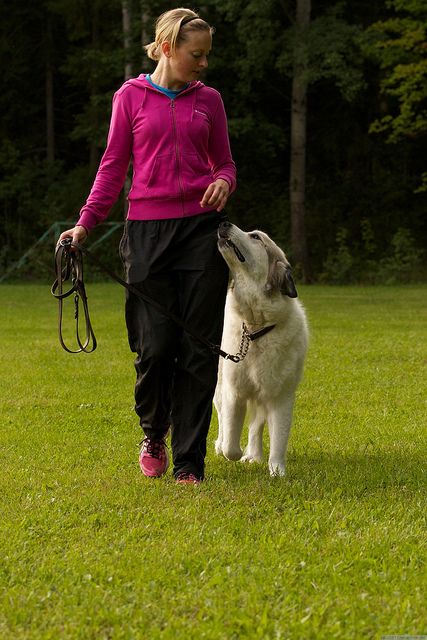By this point, we’ve covered the importance of generosity in training and the reason why your rewards should vary based on the amount of work your dog is doing. Simply changing these two variables will often solve most training problems you encounter. However, rewards are complex, and there are a few more things to keep in mind as you utilize rewards in your dog’s training. Today, let’s talk about how you reward your dog.
The way that you reward your dog matters. Rewards are information for your dog, and the more clearly you can provide that information, the more quickly your dog will learn. In our original example of the ping-ponging dog who needed to learn leash manners, I mentioned that I would reward him by my pant seam with the hand that’s closest to him (my left hand if he’s on my left side, or vise versa). This is a deliberate decision that will not only help him to learn more quickly, but will also prevent mistakes and shorten my training time.
Clicker trainers have a saying, coined by the inimitable Bob Bailey: “Click for action, feed for position.” With my leash lunger, I will click when he’s lined up at my side and looking at me, and deliver the treat or toy wherever I want his head to be. Since I always deliver the rewards where I expect his head to be, he will begin to take greater care to keep his head in the “sweet spot” where good things happen. It’s impossible for a dog to simultaneously keep his head lined up with my hip and lunge at the end of his leash, so teaching him to place his head by my side will naturally eliminate the lunging behavior. Voila! Problem solved.
The flip side of this simple training rule can cause all sorts of unwanted results. Consider, for example, what would happen if I rewarded my dog with the hand on the other side of my body. If the treat or toy were in my right hand and the dog is on my left side, I would have to reach across my body to deliver his reward. This naturally pulls the “sweet spot” to an area right in front of me – a recipe for a dog who wraps around in front of you and trips you.
This simple rule can make or break all sorts of training scenarios. Delivering a treat on the floor in between your dog’s paws will create a much stronger down-stay than giving the treat above your dog’s head, where he has to reach up to get it. It will take longer to train your dog to go to his mat if you throw the reward off the mat each time he goes to it than if you put it right on top of the mat. Placing a treat directly into your dog’s mouth when he sits will produce a better sit-stay than if he has to rock forward to lap it up. Tossing your dog’s ball behind him after the click will build a better drop on recall than having him run forward to receive it from your hand, but receiving the toy from right in front of your belly button will help you build a better obedience front. Think about where you want your dog to be when he performs a behavior, and deliver the reward to encourage that position.
How has treating for position impacted your training? Please share your experiences and tips in the comments section!


A Must have training for Dog Lover/Dog Owners,Get the Step-by-Step Free Online Puppy Training tutorial FREE of charge. http://bit.ly/T0EiMN
I have small dogs, so in regards to leash training to reward I am bending over. Are there any tricks for working with them? Also, my one dog who is about 10 pounds, can still lunge and not walk properly.
Deb, you can do several things: make your dog like that you bend over him (bending over=treats), or use a long stick with some lickable treat at the end, so you don’t need to bend.
I’m not a fan of feeding for position in some cases. It works well for relaxation exercises, but there are more effective ways to teach a dog to actively hold a position. For sit stays and down stays I’ve tried both scenarios – feeding for position, and feeding by dropping the treat further away so the dog has to get up to get the treat, and the latter works much better, and the dog understands it quicker. I do this because I want an active dog, who is very engaged in what we are doing. The dog cannot offer the down stay again if he already is in the down stay (and he was just given a treat for that). Has anybody tried both ways, too? :)
Lina, I have tried both ways. I was actually taught the first method of rewarding in place, then releasing. It did work, but I do more sit/down stay with release. I prefer this method, but do see some dogs have trouble with it initially. So, I may start out with feeding for position, and then quickly fading it out until they can wait for the release.
Helix Fairweather has some nice videos on sit stay with release as a feedback loop.
Basically, one way to think about it is that you are rewarding for the position, but in the other you are rewarding more the duration.
NICE!!